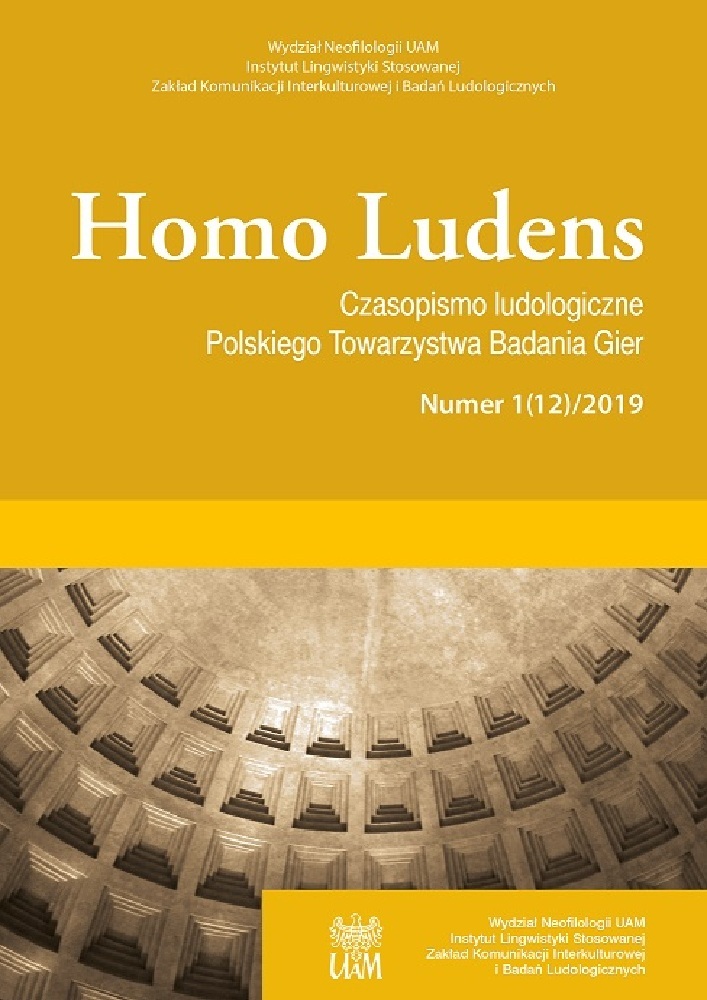Abstrakt
Niniejszy artykuł ma na celu zbadanie dwuznacznej natury przepływu oraz sposobu, w jaki ten związany jest ze skłonnością do uzależnienia. Rezultaty wstępnej analizy czynnikowej wskazują, że przepływ doświadczany przez graczy ma przynajmniej dwa komponenty, nazwane w niniejszym badaniu przepływem hedonistycznym (bezpośrednie poszukiwanie przyjemności) i eudajmonistycznym (eskapizm). Wyniki analizy regresji pokazują, że 54,4% wariancji uzależnienia od internetu wyjaśniane jest przez kompetencje życiowe, eudajmonistyczny przepływ w grze, podekscytowanie jako emocję doświadczaną podczas gry oraz irytację jako emocję doświadczaną, gdy nie istnieje możliwość grania.
Bibliografia
Abler, B., Hahlbrock, R., Unrath, A., Grön, G., Kassubek, J. (2009). At-risk for pathological gambling: Imaging neural reward processing under chronic dopamine agonists. Brain, 132(9), 2396–2402.
Arias-Carrión, O., Poppel, E. (2007). Dopamine, learning, and rewardseeking behavior. Acta Neurobiologiae Experimentalis, 67(4), 481–488.
Berridge, K. C., Robinson, T. E. (1998). What is the role of dopamine in reward: Hedonic impact, reward learning, or incentive salience? Brain Research Reviews, 28(3), 309–369.
Carver, C. S., White, T. L. (1994). Behavioral inhibition, behavioral activation, and affective responses to impending reward and punishment: The BIS/BAS Scales. Journal of Personality and Social Psychology, 67(2), 319–333.
Choi, D., Kim, J. (2004). Why people continue to play online games: In search of critical design factors to increase customer loyalty to online contents. CyberPsychology and Behavior, 7(1), 11–24.
Chou, T. J, Ting, C. C. (2003). The role of flow experience in cyber-game addiction. CyberPsychology and Behavior, 6(6), 663–675.
Csikszentmihalyi, M. (1990). Flow: The psychology of optimal experience. New York: HarperCollins.
Davis, R. A. (2001). A cognitive-behavioral model of pathological Internet use. Computers in Human Behavior, 17(2), 187–195.
Diener, E., Emmons, R. A., Larsen, R. J., Griffin, S. (1985). The Satisfaction with Life Scale. Journal of Personality Assessment, 49(1), 71–75.
Franken, I. H. A. (2002). Behavioral approach system (BAS) sensitivity predicts alcohol craving. Personality and Individual Differences, 32(2), 349–355.
Franken, I. H. A, Muris, P. (2006). BIS/BAS personality characteristics and college students’ substance use. Personality and Individual Differences, 40(7), 1497–1503.
Frankl, V. (2006). Man’s search for meaning. Boston: Beacon Press.
Greenfield, D. N. (1999). Psychological characteristics of compulsive Internet use: A preliminary analysis. CyberPsychology and Behavior, 2(5), 403–412.
Griffiths, M. D. (2000). Internet addiction: Time to be taken seriously? Addiction Research, 8(5), 413–418.
Griffiths, M. D, Dancaster, I. (1995). The effect of type A personality on physiological arousal while playing computer games. Addictive Behaviors, 20(4), 543–548.
Higgins, E. T. (1997). Beyond pleasure and pain. American Psychologist, 52(12), 1280–1300.
Kahneman, D., Diener, E., Schwarz, N. (eds.) (1999). Well-being: The foundations of hedonic psychology. New York: Russell Sage Found.
Koepp, M. J., Gunn, R. N., Lawrence, A. D, Cunningham, V. J., Dagher, A., Jones, T., et al. (1998). Evidence for striatal dopamine release during a video game. Nature, 393(6682), 266–268.
McMahan, E. A., Estes, D. (2011). Hedonic versus eudaimonic conceptions of well-being: Evidence of differential associations with self-reported well-being. Social Indicators Research, 103(1), 93–108.
Pecina, S., Cagniard, B., Berridge, K. C., Aldridge, W., Zhuang, X. (2003). Hyperdopaminergic mutant mice have higher “wanting” but not “liking” for sweet rewards. Journal of Neuroscience, 23(28), 9395–9402.
Ryan, R. M., Deci, E. L. (2001). On happiness and human potentials: A review of research on hedonic and eudaimonic well-being. Annual Review of Psychology, 52(1), 141–166.
Russell, J. A, Weiss, A., Mendelsohn, G. A. (1989). Affect Grid: A singleitem scale of pleasure and arousal. Journal of Personality and Social Psychology, 57(3), 493–502.
Shapira, N. A., Lessig, M. C., Goldsmith, T. D., Szabo, S. T., Lazoritz, M., Gold, M. S., Stein, D. J. (2003). Problematic Internet use: Proposed classification and diagnostic criteria. Depression and Anxiety, 17(4), 207–216.
Scholer, A. A., Stroessner, S. J., Higgins, E. T. (2008). Responding to negativity: How a risky tactic can serve a vigilant strategy. Journal of Experimental Social Psychology, 44(3), 767–774.
Tatarkiewicz, W. (1976). Analysis of happiness. The Hague: Martinus Nijhoff. Walther, J. B. (1999). Communication addiction disorder: Concern over media, behavior and effects. Online: <http://psychcentral.com/lib/2006/communication-addiction-disorder-concern-over-mediabehavior-and-effects/>. Accessed: 29th December 2018.
Wan, C. S., Chiou, W. B. (2006). Psychological motives and online games addiction: A test of flow theory and humanistic needs theory for Taiwanese adolescents. CyberPsychology and Behavior, 9(3), 317–324.
Waterman, A. S. (1993). Two conceptions of happiness: Contrasts of personal expressiveness (eudaimonia) and hedonic enjoyment. Journal of Personality and Social Psychology, 64(4), 678–691.
Widyanto, L., McMurran, M. (2004). The psychometric properties of the Internet Addiction Test. CyberPsychology and Behavior, 7(4), 443–450.
Young, K. S. (1996). Psychology of computer use: XL. Addictive use of the Internet: A case that breaks the stereotype. Psychological Reports, 79(3), 899–902.
Young, K. S. (1998). Internet addiction: The emergence of a new clinical disorder. CyberPsychology and Behavior, 1(3), 237–244.
